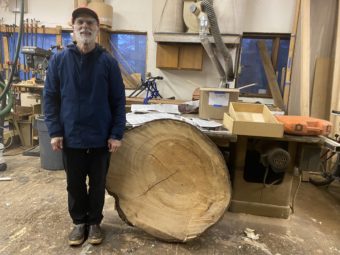
Jin Mitchem’s door hangs off its hinges, and a robin pecks around on the living room floor. A bear has scattered food wrappers it scavenged from the kitchen. Golden insulation sprays out of a ripped wall. Most of the house is leaning on the downhill neighbor’s home, like a kid leaning on a parent’s shoulder, and the front stairs are lying flat on the ground.
“Honestly, it’s hard to know where to start,” Mitchem said.
Falling trees destroyed his home when a late September storm triggered a landslide above Gastineau Avenue. Mitchem left for work about an hour and half before one tree skewered through the living room window.
Now homeowners and the community are grappling with how to respond. And with another question — who pays?
For Mitchem, the answer so far has been “friends and kind strangers.”
A friend started an online fundraiser for Mitchem that’s raised nearly $50,000 so far. He said he can’t even count the number of people who have offered to let him stay in their homes.
“Right now, I don’t have a house. But, you know, I have life. I have friends. And last week I learned I have a community,” he said.

Mitchem just moved from a hotel to a temporary apartment. His insurance is paying for his stay. After that, he’s not sure.
“It kind of depends on whether my insurance agrees to cover for the situation or not,” he said.
The situation involves tree removal, demolition, preparing the land and a house rebuild.
His downhill neighbors are also displaced — the electricity isn’t even back on in their apartments.
Mitchem says he thinks he’d like to rebuild, but he has some concerns about the location now. His home is in a severe landslide hazard zone, according to city maps.
Landslide insurance is ‘exceedingly hard’ to get
City officials say the fallen trees are what totaled his house. That’s good news for Mitchem, because he doesn’t have landslide insurance. Most people don’t.
Juneau homeowners looking for landslide insurance have a tough time. Some say mortgage brokers have told them they simply cannot get landslide insurance in Southeast Alaska anymore.
“It is available. But it’s been extremely hard to write,” said Emil Mackey, an insurance agent in Juneau. He says he gets an automatic rejection when he tries to get landslide insurance for Juneau clients.
He says that’s because of fatal and destructive landslides in the region. The 2015 slide in Sitka and 2020 slide in Haines changed how insurers view risk region-wide.
“No matter where you are in Juneau, if you’re within one mile of any historic landslide, which is anybody near a mountain, which is everybody in Juneau — yes, it takes basically a geo survey to get approved,” Mackey said.

A geotechnical survey can cost thousands of dollars.
Mackey says this latest landslide is likely to affect insurance, too. And not just in Juneau.
“I think it’s actually going to affect the availability of landslide insurance throughout Alaska, because most insurance companies actually consider risks on a state level or a county level and not necessarily on a city level,” Mackey said.
Accelerating change
Both of Carole Triem’s homes are in landslide zones. The Juneau Assembly member is calling for the city to do a better job responding to landslides. And, no, she does not have landslide insurance.

Triem isn’t an outlier — roughly half of the downtown area is in a hazard zone for landslide or avalanches, according to the city’s new hazard maps. But she says it’s more than downtown hazards. Flooding in the Mendenhall Valley at Jordan Creek and erosion on waterways are some examples.
“They’re just going to become more frequent and have greater severity,” she said. “I think that that means our role is going to have to change, it’s going to look different than it has historically, just because the planet is changing.”
Triem says 20 years ago, risk calculation was more static in Juneau — residents could be expected to make their own risk assessments.
“Climate change is changing that. I think that now that means that we have a role to play as a city government in helping people figure out what those risks are,” Triem said.
After the landslide on Gastineau Avenue, the city cleared the road. Deputy City Manager Robert Barr says that’s been its main job so far. They may relocate a culvert for better hillside drainage. But he says further involvement isn’t in the playbook, yet.
“It’s not that the community has decided to do nothing,” Barr said. “It’s that the community has decided to move forward in a more individualistic nature about thinking about risk and these sorts of emergency events.”

In other words, as a community, Juneau hasn’t made a plan for how the local government should be involved after a landslide destroys a home or a neighborhood.
But Barr said that could change. The assembly will resume talks about new hazard maps and what they mean next month.
Barr said the city could decide to move forward in a more “communal perspective,” where the city could change building codes or adopt plans that conform to the latest scientific knowledge of the area.
The city has considered buyouts in hazard zones before — that’s where the city buys dangerous property so people don’t continue living there. The assembly rejected those proposals for Behrends Avenue in 2008.
Barr says the city hasn’t considered buyouts for the homes damaged by this landslide.
Looking over the wreckage of his home, Mitchem says that’s an offer he might take.



